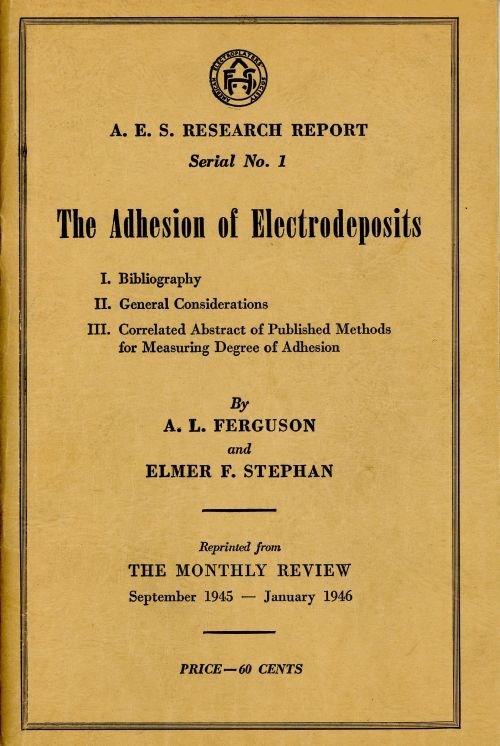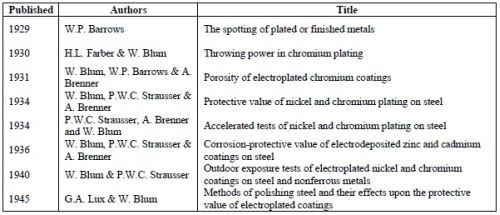AES Research Project 3, Adhesion of Electrodeposits, Prologue
This is the prologue for a four-part article consisting of the full report of AES Research Project #3, Adhesion of Electrodeposits, done at the University of Michigan in the mid-1940s, following the end of World War II.
by
Project Director: A.L. Ferguson
Associate: Elmer F. Stephan
Chemistry Department, University of Michigan, Ann Arbor, Michigan
Prologue
by
James H. Lindsay
NASF Technical Editor
Editor's Note: This is the prologue for a four-part article consisting of the full report of AES Research Project #3, Adhesion of Electrodeposits, done at the University of Michigan in the mid-1940s, following the end of World War II. A printable version of this prologue can be downloaded by clicking HERE.
Early development of the AES Research Program
In January 1927, the AESF Foundation Research Program (then AES) was launched at the then-National Bureau of Standards (now the National Institute of Standards and Technology (NIST)).
Under the direction of Dr. William Blum, nine research projects were completed in the period from 1927 to 1942.* The NBS provided consultation and working facilities, while the AES Research Committee chose a number of Research Associates to undertake the work. The AES Research Fund was generously supplied by contributions from industry, the AES Branches and its membership. Publications first appeared in the National Bureau of Standards Journal of Research, and these works were later designated “Series A.”
Then came World War II, and the NBS priorities shifted to winning that historically-critical conflict. After the war, the AES Research Program was reorganized, and fellowships were established at a number of educational institutions and industrial laboratories, directed by a Project Director and supervised by the AES Research Committee. This arrangement continues to this day, with the 118th project being undertaken at the University of Houston, directed by Dr. Stanko Brankovic on the in situ study of cracking phenomena during chromium deposition from trivalent solutions. These post-war works, originally designated as “Series B,” were published in the AES Monthly Review and subsequent titles (Plating, Plating & Surface Finishing and currently in the NASF Report in Products Finishing magazine), in other journals, e.g., the Journal of the Electrochemical Society, or in separate reports.
As is true today, each project involved publication of quarterly reports, which were serialized in the society/association journals. From the Fall of 1944 through the early 1960s however, these individual reports were combined into complete reports in booklets made available for purchase. Called AES Research Serial Reports, these publications were eventually discontinued owing to cost.
The first AES Research Serial Reports

Why publish now?
The material contained in these Serial Reports is over 70 years old, and one might rightfully question the value of republishing this material as we approach the third decade of the 21st century. I could tell you that the history of our industry remains important today, and that “those who ignore history are condemned to repeat it,” but this particular subject is more than that.
The adhesion of surface coatings to their substrates remains a primary factor in validating coatings in our industry. The coating may have all of the properties required for a given application, but if it doesn’t stick, it’s back to the drawing board.
This research project was unusual in that it wasn’t a laboratory project; rather it was a comprehensive literature and industry survey of the development of adhesion concepts and measurements from the early 1900s to the end of World War II. During that period, our industry developed from an art to a science, accelerated by the urgency of the global conflict. This was a critical story which spawned the technology of process and measurement that we have today. The story continues to give insight into early thinking which still may benefit those now in the field.
Any inspection of many of the papers printed in the journals of the AES (and AESF and NASF) in the last half of the 20th century shows that much of that research and engineering work remains relevant. Arguably, many of those folks, “got it right the first time.” With that in mind, knowledge of the historical perspectives on plate adhesion benefit those who brought the industry technology to what it is today, and can benefit those developing the technology to come.
A word about the contents
As noted above, this project on the adhesion of electrodeposits was a comprehensive survey of all of the literature on the subject. But it was more than that, involving interviews with key persons in the industry as well as scientific reports. The complete package is organized into four sections:
- The bibliography – The first part of research involves a study of the literature, which of course is usually reported at the end of a paper. In a departure from that, Dr. Ferguson, published the bibliography first, as it was the first product of the project, and all references in this list are cited throughout the rest of the report(s).
- General considerations –Dr. Ferguson discusses the science of adhesion, as it was understood circa 1945. Concepts are thoroughly discussed in a general sense.
- Published adhesion measurement methods – A survey of all the work and concepts from the published papers is quoted an analyzed, providing a state of the art after the War and how they all got there.
- Interview comments on adhesion measurement methods – Correspondence directed to many of those authors as well as those in the industry working with adhesion problems is the basis for the material in this last section. This involves private communications from about 75 practical platers and administrators.
The reader will note that this material has been carefully edited for matters of format. The output of many people involves writing in different styles and using different units. Although metric and English units are unchanged, I attempted to unify the units, abbreviating them throughout. Thus, “pounds per square inch,” “lb. per sq. in.,” etc., all became “psi;” ... and so on. Also, the nature of this report involved extensive quotations from the papers and interviews. In the original report, in an attempt to perfectly quote the material, figure numbering referred both to the original author’s figure numbering and the numbering in this report. Thus, this report contained the awkward construction “.... in Figure 1 (our Figure 24), ...” The quotes are amended to show only the figure number in the Serial Report(s). Finally, given the publication quality of the times, many of the figures remain difficult to interpret, despite the editor’s best efforts to clarify things through digital scanning and photo enhancement. I hope that the reader will bear with me on that.
It is hoped that the reader will find this material invaluable in advancing adhesion technology today. Perhaps those studies of “mechanical mayhem” in the 20th century and the quest for a non-destructive test regimen will benefit today’s engineers and scientists.
About Dr. Alfred Lynn Ferguson:
Originally published by the University of Michigan in the Proceedings of the Board of Regents, on the occasion of Dr. Ferguson’s retirement on June 6, 1954:
“The Regents of the University of Michigan extend their hearty congratulations to Professor Alfred Lynn Ferguson, who on June 6, 1954, reached his seventieth birthday and accordingly became eligible for retirement as of the end of the academic year 1953-1954. A native of Grass Lake, Michigan, the holder of three degrees, including the Ph.D. degree, from the University of Michigan, Professor Ferguson in 1911 joined the Department of Chemistry as a teaching assistant and advanced in 1944 to the position of Professor of Chemistry. He has achieved in addition to his reputation as a teacher a long and distinguished record of important research, including a number of projects he directed for the Engineering Research Institute. He has repeatedly been called upon by several Michigan chemical industries as a consultant. In 1949, he was elected president of the Electrochemical Society. As he enters the emeritus status the Regents of the University of Michigan give to him their sincere thanks for his forty-three years of devoted and loyal service. They furthermore confer upon him the title Professor Emeritus of Chemistry and invite him to avail himself of all the courtesies customarily extended to emeritus members of the faculty.”
Footnote

Related Content
Understanding and Managing White Spots on Anodized Aluminum
Having trouble with spotting defects when anodizing? Taj Patel of Techevon LLC offers a helpful overview of the various causes of white spots and potential solutions.
Read MoreHow to Address Declining Powder Coating Coverage Over Time
Fine particles from reclaim could be to blame for powder coating problems that emerge over time. Avoid problems by keeping hooks clean, maintaining guns and using reclaim powder quickly to avoid accumulation of fines.
Read MoreHow to Maximize Nickel Plating Performance
The advantages of boric acid-free nickel plating include allowing manufacturers who utilize nickel plating to keep up the ever-changing regulatory policies and support sustainability efforts.
Read MoreRead Next
Education Bringing Cleaning to Machining
Debuting new speakers and cleaning technology content during this half-day workshop co-located with IMTS 2024.
Read MoreDelivering Increased Benefits to Greenhouse Films
Baystar's Borstar technology is helping customers deliver better, more reliable production methods to greenhouse agriculture.
Read MoreA ‘Clean’ Agenda Offers Unique Presentations in Chicago
The 2024 Parts Cleaning Conference, co-located with the International Manufacturing Technology Show, includes presentations by several speakers who are new to the conference and topics that have not been covered in past editions of this event.
Read More





















